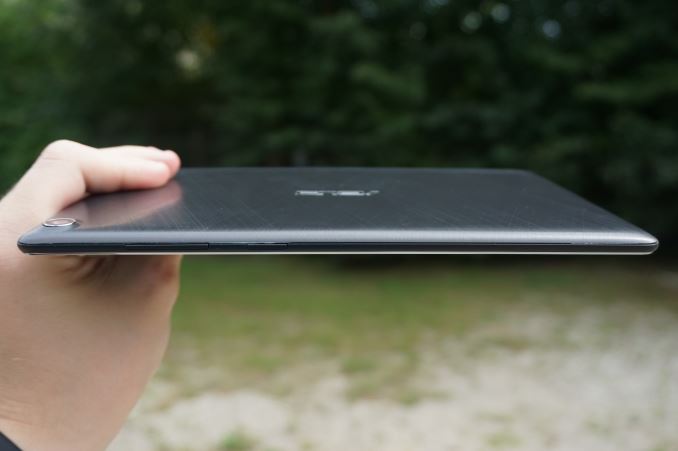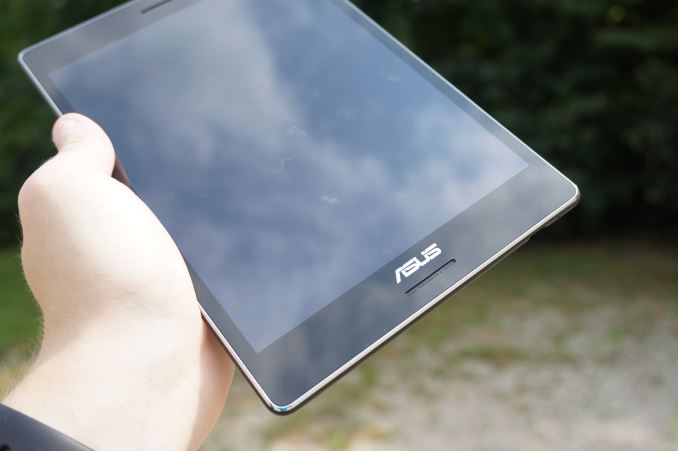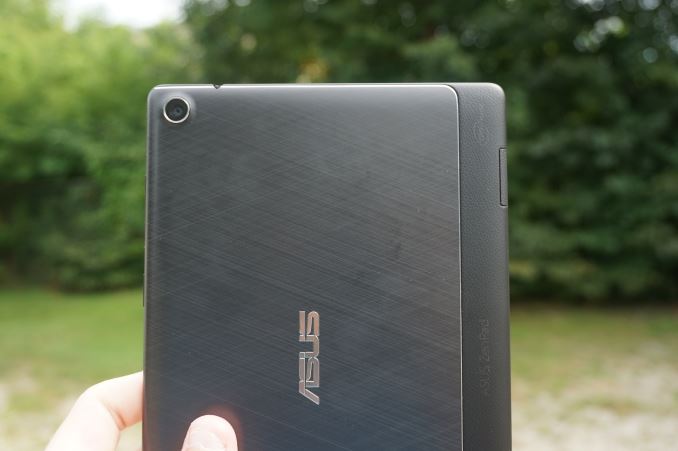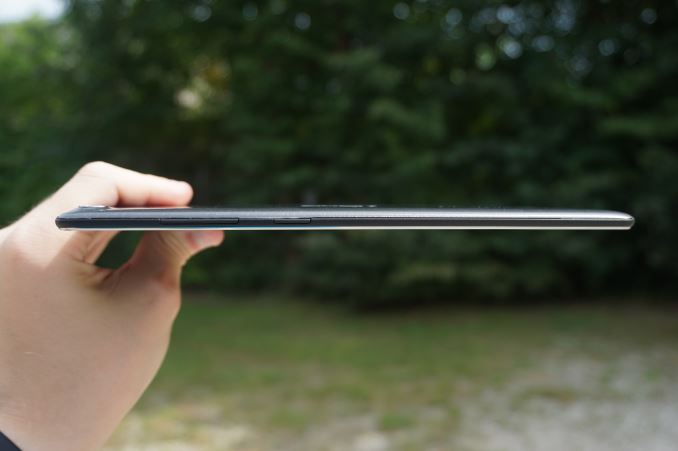The ASUS ZenPad S (Z580CA) Review
by Brandon Chester on August 31, 2015 8:00 AM ESTDesign
In my mind, I think of the ZenPad S Z580CA as a companion to the ZenFone 2. Both devices have an affordable price, and you can really buy both of them and still end up spending less than you would on a flagship smartphone. While they definitely share a UI and many internal hardware components, there isn't much similarity between the external design and construction of the two devices.
The first thing you'll notice when you pick up the ZenPad S isn't how the materials feel, but how incredibly thin and light the entire device feels. It's 6.6mm thick at its thinnest point, and the thickest point is only a small fraction of a millimeter thicker than that. Its mass is only 298g, which makes it the lightest tablet I've looked at to date. While it's not as thin as the iPad Air 2 or the Dell Venue 8 7840, the thickness and mass work together to give a feeling of lightness and portability that I've only ever experienced with one other device, which was the original iPad Mini.
There's not much to say about the front of the ZenPad S. Like all tablets, it's just a big display. ASUS has made space for two front-facing stereo speakers, which is something you won't get on an iPad or on the Galaxy Tab S2. As for the quality of the speakers, my highly subjective evaluation is that they are better than the iPad Air 2, and much better than the Nexus 9. They also don't cause significant chassis vibration despite the tablet's small thickness, which is something the iPad Air 2 suffers from.
Surrounding the edge of the ZenPad's front bezels is a metallic looking silver edge. This is really made of plastic, and like the plastic construction of the ZenFone 2 I'm a bit concerned about its durability. Readers may remember that a single fall from an extremely short height ended up scuffing up the back cover of our ZenFone 2 pretty badly. With the ZenPad S I have made sure to be quite careful, and haven't dropped it or hit it off anything to the best of my knowledge. Even so, there are some small dents in the silver edge. Pressing on it confirms that it's a fairly soft plastic, and I feel like it's going to be a magnet for these types of small dents and marks. In contrast, the Nexus 9 and iPad Air 2 testing units I have could probably be packaged and sold as brand new despite having them in my possession for significantly longer than the ZenPad S. If someone intends to use the ZenPad S as a tablet they can throw into their bag with other objects I would definitely be aware of the potential for damage to the edge.
The back of the ZenPad S is split into two sections. The smaller section has a soft touch feeling, and almost feels a bit like the pleather some phone cases are made of as it has a texture to it. This section is slightly thinner than the rest of the back cover, and it houses the tablet's MicroSD slot. What's interesting is that this part blends smoothly into the sides of the tablet, even though the sides have a distinctly different feeling due to their lack of texture. The soft touch part of the tablet also has the tablet's name and the Intel logo on it. However, it rubs off fairly easily as you can see in the image above, and at the time of writing this paragraph the logos have come off entirely.
The second part of the ZenPad back cover is a large plastic panel. In my review of the ZenFone 2 I said that the back cover of the phone did a good job of mimicking the appearance of aluminum, but felt entirely like plastic. The plastic segment of the ZenPad's back cover could actually convince you that it's made of metal unless you have the urge to tap on it. Like the ZenFone 2, the ZenPad's back cover has a shine to it that looks very much like the reflections made by brushed aluminum, although in the ZenPad's case the back cover has a pattern of overlapping diagonal lines rather than the straight lines of the ZenFone 2. Unfortunately, the hard plastic part of the back cover doesn't give any illusion of the tablet itself being made of metal, as you'll always be touching the soft touch plastic of the sides and the smaller segment of the back.
Right out of the box, my ZenPad S review unit did seem to have some issues with the hard plastic segment of the back cover that I think should have been picked up during QA. As you can see in the images above, there are areas on the edge of the plastic that are warped in such a way that they are no longer smooth like the other sections. It looks like these areas weren't finished properly, and when you look at the tablet from the side you can see that the entire edge around the power button and volume rocker is improperly formed and doesn't have the same color as the rest.
Ultimately I think the ZenPad S does a good job at being what it is, which is a tablet with a plastic chassis. My big concern is that the iPad Mini 2 sits at exactly the same price, and offers a completely aluminum chassis that feels much higher quality and will likely not incur the damage I've seen on the ZenPad's edge and back cover. The iPad is obviously heavier and thicker though, and the only way to achieve the low mass that the ZenPad S has is with plastic.
Personally, I think if I was given the choice I would opt for a slightly thicker and heavier device made of aluminum or a more durable plastic than a thinner and more easily damaged plastic one. The thicker device also has the benefit of storing a larger battery. Other people may value the thinness and the lightness more, particularly with 8" tablets which are more likely to be kept on someone's person than larger tablets. In the end everything is a series of trade-offs, and it's important to think about what aspects of design and build quality matter most to you when considering which tablets to buy.














114 Comments
View All Comments
MrSavage - Monday, August 31, 2015 - link
The review never mentioned the speakers so how would you know how they perform? By the sounds of it, elitist much?mischlep - Monday, August 31, 2015 - link
"... ASUS has made space for two front-facing stereo speakers, which is something you won't get on an iPad or on the Galaxy Tab S2. As for the quality of the speakers, my highly subjective evaluation is that they are better than the iPad Air 2, and much better than the Nexus 9."MrSavage - Monday, August 31, 2015 - link
Thanks. I lost that one. I suppose that was buried amongst the charts and graphs. I guess no need to audio to be part of the drop down tabs?Brandon Chester - Monday, August 31, 2015 - link
It's in the design section in the paragraph discussing the front face of the tablet. Since it's the most subjective evaluation ever I didn't feel it would merit its own section, and I just mentioned it because using the speakers on a phone/tablet for music or movies is apparently something more people do than I realized.MrSavage - Monday, August 31, 2015 - link
Tablets = consumption = audio reliant (largely). How that cannot be a focal point of a tablet review I suppose I won't understand fully. I guess people want charts and graphs? I get the tech savvy demo of anandtech and perhaps they need charts and graphs to decide whether something is a good value or not.MrSavage - Monday, August 31, 2015 - link
With respect (and I'm full of typos myself), but there is a typo in your review.Brandon Chester - Monday, August 31, 2015 - link
The idea that tablets = consumption is demonstrably false. I have done a great deal of writing using Office for Android and iOS.MrSavage - Monday, August 31, 2015 - link
We can't talk about exceptions. Those always exist. The audience reading a tablet review are from which camp? The strong majority are using their tablets for "things" that use audio. If you are not so much into consumption like the majority of consumers are, then I wonder why no mention of a Z stylus. A stylus isn't about consumption. If you could find sources online stating that a tablet is largely a consumption device, then we visit different websites over the years.MrSavage - Monday, August 31, 2015 - link
My typo (why on earth no edit), "If you can't find"Brandon Chester - Monday, August 31, 2015 - link
Because ASUS didn't send the stylus. I'm not going to comment on the quality or utility of something I haven't used. I think I've said all I need to say.